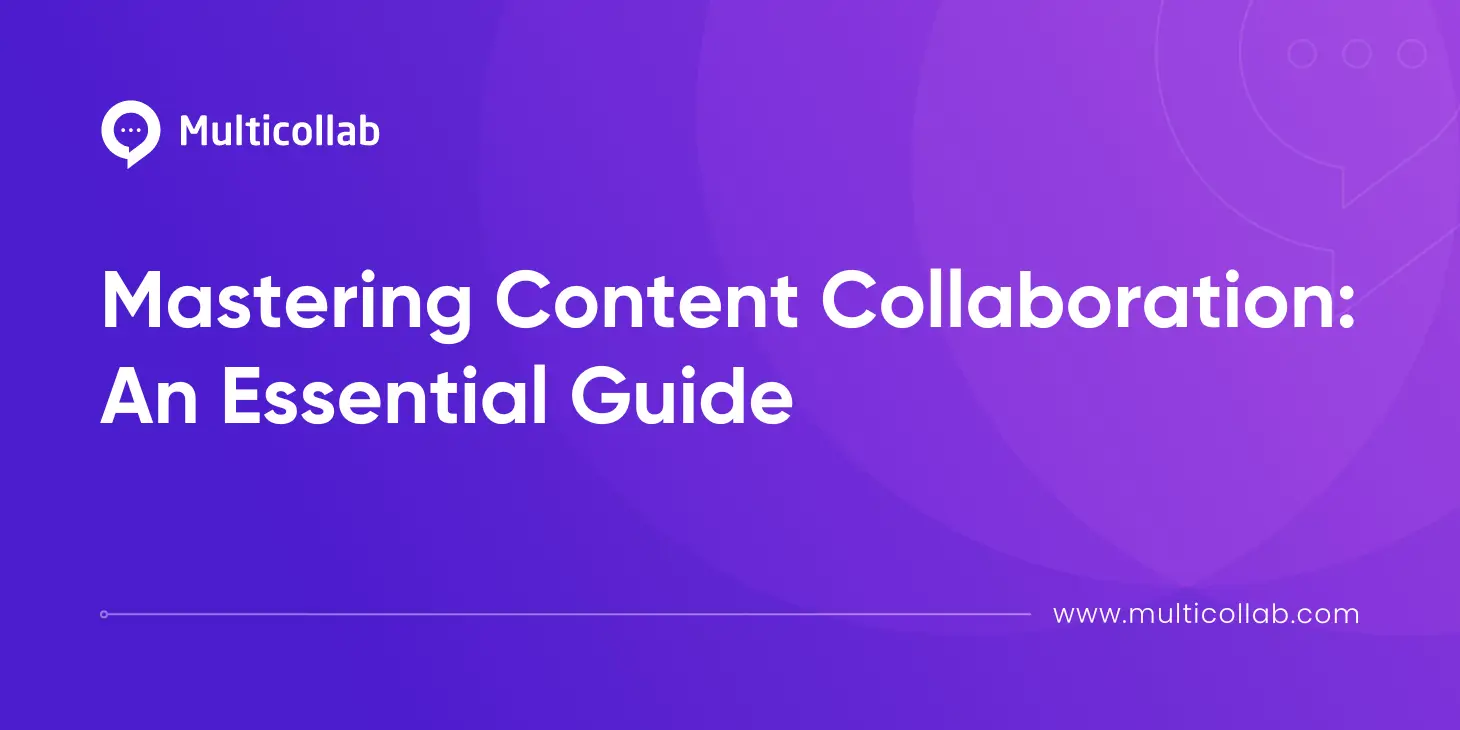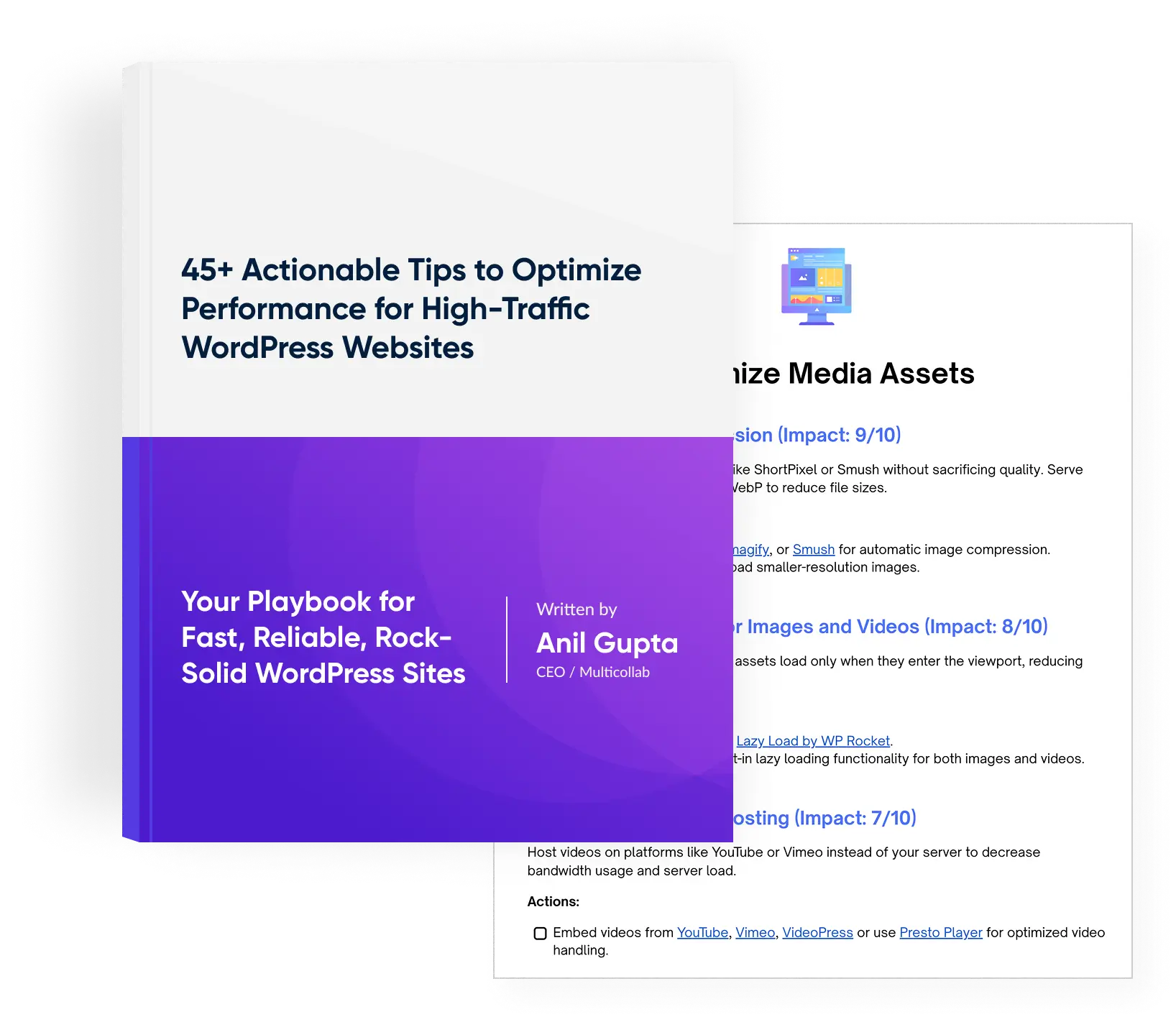Table of Contents
When talking about content creation, the paradigm of collaboration has undergone a profound transformation. This change has been catalyzed by technological advancements and the global shift towards remote work, accelerated by the COVID-19 pandemic. Online content collaboration tools have transitioned from being mere conveniences to indispensable digital assets, facilitating seamless teamwork across geographical boundaries.
Content collaboration offers businesses numerous advantages, enhancing productivity, innovation, and efficiency. By allowing team members to work together on documents in real-time, it streamlines workflows and minimizes communication hurdles, boosting productivity. Diverse perspectives often lead to innovation as teams generate fresh ideas and solutions. Tools for content collaboration enable easy access to documents from any location with internet access, facilitating asynchronous work and improving efficiency. They also include features like version control, ensuring teams can track changes and maintain a coherent workflow.
Despite these benefits, challenges such as managing team dynamics and ensuring data security can arise. Effective communication and conflict resolution are crucial to maintaining harmony within the team. Additionally, businesses must implement robust security measures to protect sensitive information shared on collaborative platforms, addressing concerns like unauthorized access and compliance with privacy regulations. Achieving a balance between collaboration benefits and these challenges requires careful planning and implementation of appropriate policies and protocols.
Benefits and Risks of Content Collaboration
Content collaboration offers numerous benefits for businesses and individuals alike, but it also comes with its own set of risks. Let’s explore both aspects:
Benefits of Collaborative Content Creation
Improved team productivity: Tapping into the diverse skills, knowledge, and experiences of team members allows for the delegation of tasks based on individual strengths and expertise, leading to a more streamlined workflow and optimized resource utilization.Effective utilization of skills: Pooling diverse skill sets optimizes resource utilization and capitalizes on individual strengths.
Fostering innovation through brainstorming: Creating a conducive environment for idea-sharing fosters creativity and problem-solving by encouraging open exchange of diverse perspectives. This cultivates psychological safety, empowering individuals to explore innovative approaches without fear of criticism.
Faster content generation: Streamlining collaborative processes expedites idea generation, refinement, and execution by eliminating barriers and optimizing workflow efficiency. Clear frameworks and tools facilitate rapid iteration and timely feedback, accelerating the transition from ideation to implementation.
Streamlined workflows: Coordinated task management ensures smooth progression and minimizes bottlenecks by allocating responsibilities effectively and maintaining clear communication channels. Teams can maximize efficiency at every stage of the content creation process, fostering collaboration, reducing turnaround times, and ultimately enhancing the quality and timeliness of content delivery.
Risks of Collaborative Content Creation
Communication breakdowns: Collaborating on content projects, especially in a remote environment, can lead to communication issues due to challenges like misinterpretation of written messages, technical glitches, and differences in communication styles.
Data security concerns: Collaborating on content projects often involves sharing sensitive information across digital platforms. Without proper encryption measures or secure communication channels, there’s a heightened risk of data breaches, unauthorized access, or leaks of proprietary information.
Lack of accountability: When team members are unclear about their specific duties or the expectations placed upon them, it can lead to confusion, duplication of work, or even neglect of critical tasks.
Difficulty in tracking changes: Collaborative content projects often involve multiple contributors making edits and revisions to shared documents. Without robust tracking mechanisms or centralized management tools in place, team members may struggle to identify the most current version of a document or reconcile conflicting edits. This can lead to confusion, inefficiencies, and potential errors in the final output.
Exploring Top Content Collaboration Tools
Effective content collaboration tools serve as catalysts for overcoming the hurdles associated with collaborative content creation. By providing robust features tailored to the needs of collaborative teams, these tools empower users to communicate effectively, share files, manage tasks efficiently, and ensure the security of shared information. Whether it’s brainstorming ideas, drafting content, or reviewing edits, the right content collaboration platforms and tools can streamline workflows and maximize productivity.
It’s essential to recognize that there is a wide array of collaboration tools available, each designed to address specific needs and preferences. From file-sharing platforms to project management platforms to document collaboration software, the options are diverse and varied. For readers seeking comprehensive information on different types of collaboration tools, Multicollab offers a complete guide on collaboration tools to help you get started.
Essential Features of Content Collaboration Software
When selecting the best content collaboration platforms and tools, certain features are indispensable for facilitating effective collaboration on content projects. These include:
Real-time editing capabilities: Enabling multiple users to edit documents simultaneously, fostering collaborative content creation in real-time.
Built-in notifications: Alerting users to changes, comments, and updates in shared documents, ensuring timely communication and feedback.
Customizable user permissions: Allowing administrators to control access levels and permissions, safeguarding sensitive content and data.
Activity workflows: Providing structured workflows for content creation, review, and approval processes, enhancing efficiency and accountability.
Several leading content collaboration tools stand out for their robust features and user-friendly interfaces. Here’s a brief overview of some of the top options:
1. Multicollab
Multicollab stands out as a document collaboration plugin designed for WordPress users. It offers extensive collaboration features, customizable permissions, and advanced reporting tools. With its unique approach to real-time collaboration in WordPress, Multicollab empowers teams to synchronize efforts across editorial projects for unparalleled productivity. Users can attach documents to their comments, receive workflow insights, and manage permissions for adding comments and suggestions.
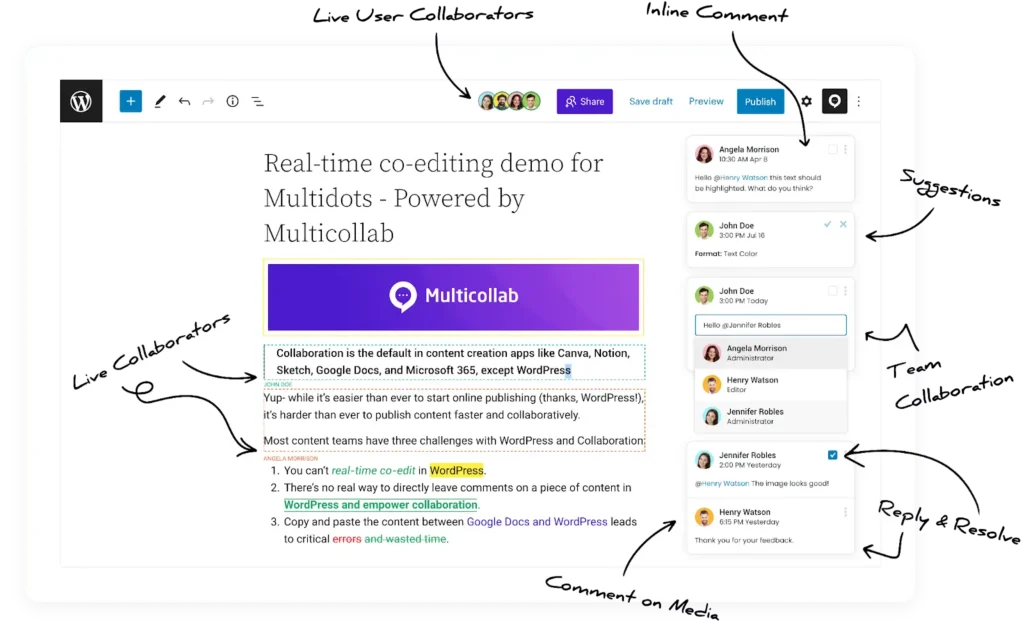
Key features of Multicollab include:
- Real-time co-editing for simultaneous work on the same document.
- Inline commenting with the ability to attach documents to comments, fostering contextual communication.
- Custom user permissions and access control to manage document security effectively.
- Activity timeline for tracking progress across all projects.
- Suggestion mode for detailed tracking of changes.
2. Google Docs
Google Docs revolutionizes collaboration with real-time editing, enabling multiple users to work on the same document simultaneously. Its commenting and suggestion features facilitate seamless feedback exchange, while revision history allows for tracking changes and restoring previous versions effortlessly. With shareable links and precise permissions, users can control document access and foster collaboration across teams.
Integration with Google Chat streamlines communication, letting collaborators discuss and edit documents within the chat interface. Presence indicators and built-in chat further enhance real-time collaboration, while third-party integrations extend functionality across various platforms, making Google Docs an indispensable tool for efficient, cross-functional teamwork.
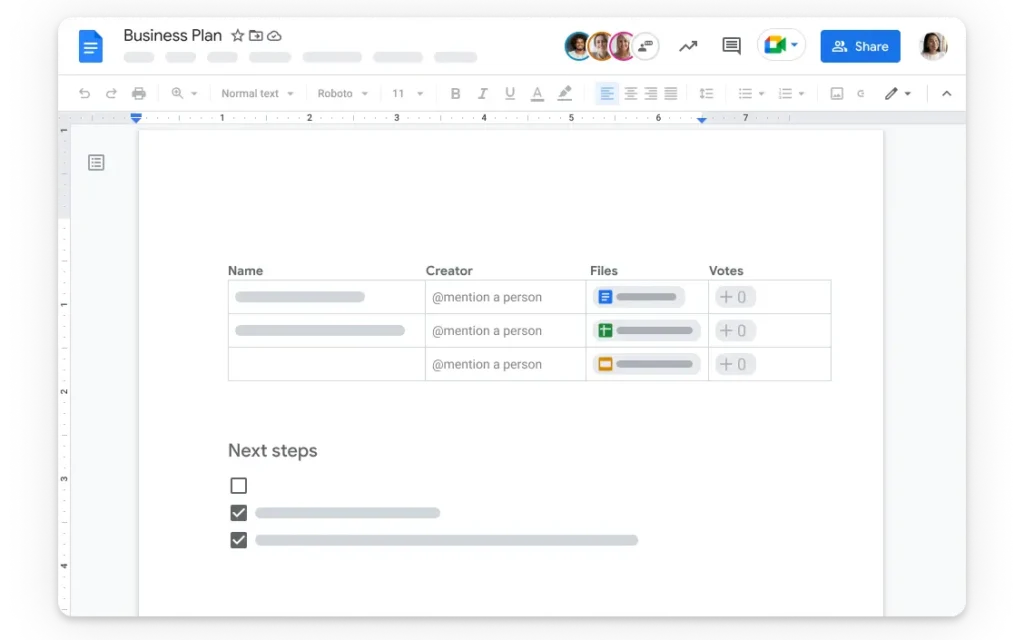
3. Zoho Writer
Zoho Writer is a powerful online word processor that offers a comprehensive suite of features for creating, editing, and collaborating on documents. With its intuitive interface and seamless integration with other Zoho productivity tools, users can effortlessly streamline their workflow and enhance productivity.
Zoho Writer supports real-time collaboration, allowing multiple users to work on the same document simultaneously, and provides robust version control capabilities to track changes and revisions. Additionally, Zoho Writer offers advanced formatting options, templates, and automation features, making it a versatile solution for individuals and teams seeking to create professional-quality documents efficiently.
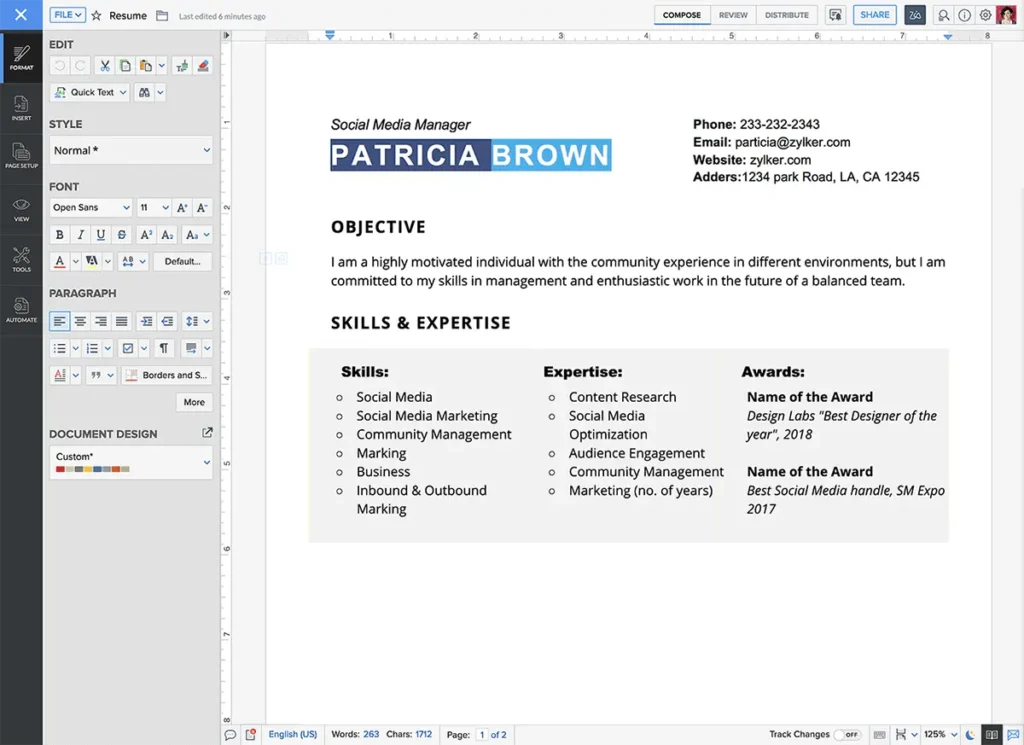
4. Dropbox Paper
Dropbox Paper combines document creation with collaboration features, allowing users to create, edit, and share documents in a collaborative workspace. With its minimalist interface and intuitive design, users can easily create and organize documents, add rich media content, and collaborate with teammates seamlessly. Dropbox Paper supports real-time commenting and feedback, enabling teams to collaborate effectively without the need for multiple versions of a document.
It integrates seamlessly with other Dropbox services, providing users with easy access to their files and enabling smooth workflow integration. Additionally, Dropbox Paper offers features such as task management, timelines, and @mentions, making it a versatile tool for project management and collaboration.
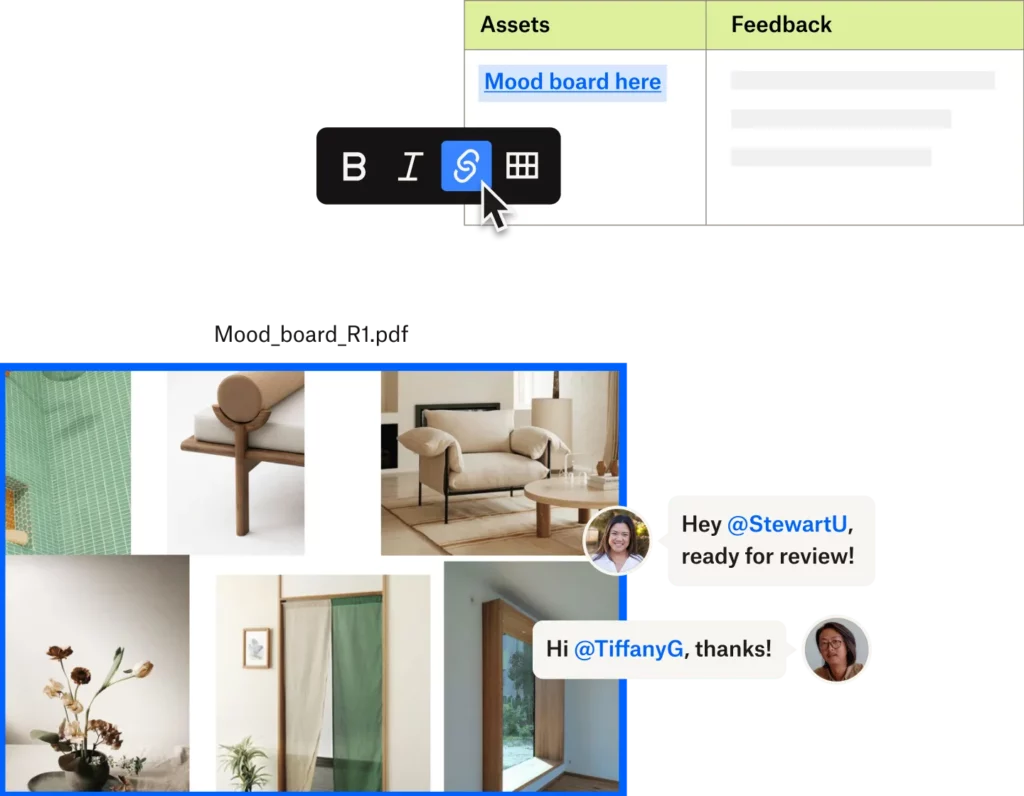
For readers seeking a more extensive list of top document collaboration tools, Multicollab’s guide on top document collaboration tools offers comprehensive insights and recommendations.
Selecting the right content collaboration tools is crucial for optimizing collaborative content creation processes. By understanding the diverse range business benefits of tools available and prioritizing essential features, teams can enhance productivity, streamline workflows, and drive successful outcomes in collaborative content projects.
Optimizing Content Collaboration Practices to Improve Efficiency
Optimizing content collaboration practices is essential for avoiding inefficient processes for producing content, and maximizing productivity in collaborative content teams. By implementing best practices tailored to create content and to enhance collaboration effectiveness, teams can streamline workflows, foster innovation, and achieve successful outcomes in content creation endeavors. Below, we’ve curated some best practices to help you optimize your content collaboration efforts.
Define Clear Goals and Expectations
Clear goal definition is paramount in guiding collaborative efforts towards desired outcomes. By articulating clear objectives and expectations from the outset, teams can align their efforts and focus on achieving shared goals. Establishing SMART (Specific, Measurable, Achievable, Relevant, Time-bound) goals provides a framework for assessing progress and ensuring accountability throughout the content creation and review process.
Define Clear Roles and Responsibilities
Assigning clear roles and responsibilities to collaborative team members and the project lead is essential for ensuring accountability and maximizing efficiency. By delineating individual tasks and responsibilities, teams can minimize confusion, avoid duplication of efforts, and capitalize on each member’s strengths and expertise. Regularly revisiting and updating role assignments ensures alignment with evolving project requirements and team dynamics.
Improve Communication with Real-time Collaboration Tools
Effective communication lies at the heart of successful content collaboration. Leveraging real-time collaboration tools, such as messaging platforms, video conferencing software, and project management tools, enhances communication transparency and facilitates seamless information sharing among team members. Embracing asynchronous communication channels allows for flexibility and accommodates diverse work schedules across multiple departments, enabling continuous collaboration with external stakeholders irrespective of geographical constraints.
Plan Your Content Publishing Workflow Carefully
Careful planning of the content publishing workflow is essential for ensuring smooth execution and timely delivery of content projects. By establishing a structured workflow encompassing content ideation, creation, review, and publication stages across multiple projects, teams can minimize bottlenecks, track progress, and optimize resource allocation. Implementing project management methodologies, such as Agile or Kanban, provides a framework for prioritizing tasks, managing dependencies, and adapting to changing project requirements.
Measure Your Results and Keep Iterating on Your Content Process
Continuous measurement and evaluation of content performance are critical for driving iterative improvements to create high-quality content that targets the right audience and refines the overall content creation processes. By tracking key performance indicators (KPIs), such as audience engagement metrics, conversion rates, and content reach, teams can gain insights into the effectiveness of their content strategy and identify areas for optimization. Embracing a culture of experimentation and learning encourages innovation and enables teams to evolve their content processes based on data-driven insights.
Optimizing content collaboration practices is instrumental in improving efficiency, driving innovation, and achieving success in collaborative content projects. By adhering to best practices such as defining clear goals, assigning roles and responsibilities, enhancing communication, planning workflows, and measuring results, virtual collaboration teams can unlock complex projects’ full potential and deliver impactful content that resonates with their target audience.
Elevate Your Content Game with Multicollab
Content collaboration is pivotal for enhancing productivity, ensuring content quality, and maximizing efficiency in today’s dynamic digital landscape. Effective collaboration necessitates a combination of best practices and the right tools to streamline workflows and drive successful collaboration outcomes.
Multicollab emerges as a premier solution for content collaboration, offering a comprehensive suite of features tailored to meet the diverse needs of collaborative teams. With its intuitive interface, real-time editing, file sharing capabilities, customizable user permissions, and advanced activity workflows, Multicollab empowers teams to collaborate seamlessly and achieve their content goals with precision and efficiency.
Don’t wait any longer to elevate your content team’s collaboration efforts. Get started with Multicollab today and unlock the full potential of collaborative content creation.
| References | |
|---|---|
| 1 | Google Docs |
| 2 | Zoho Writer |
| 3 | Dropbox Paper |


